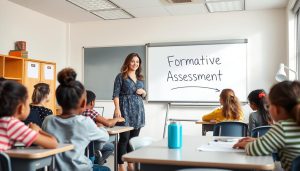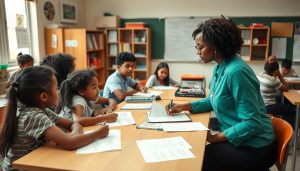Educators in the 21st century are more focused on implementing culturally responsive practices and strategies in the classroom than ever before. These practices emphasize diversity, inclusiveness, and empathy and are also tied to desired learning outcomes and academic achievement.
Every student feels valued and seen in a culturally responsive learning environment, leading to higher engagement and participation. Teachers have shifted away from the traditional “one-size-fits-all” methods of the past toward culturally responsive practices in response to what works best for the diverse student population.
This shift in how teachers lead and instruct has resulted in more diverse and dynamic classrooms emphasizing the strengths each student brings to the table (versus their weaknesses) and a willingness to use what is already familiar to students to help them learn and apply new concepts. The curriculum in a culturally responsive education environment will include multicultural content and a variety of assessment methods, giving all students opportunities to make connections between their lives and their world.
Use the strategies below in your school to create an environment where diversity is celebrated, students are valued, and engagement is strong.
Set Up Your Classroom for Success
Teachers should consider how the classroom’s physical environment and instructional materials represent and reflect a diverse student population. This might include an overhaul of the classroom library, for example, working to ensure the books available to students have a wide variety of characters from all walks of life. Students should not be limited, for example, to content that only reflects middle-class or suburban white families. Age-appropriate books written by a diverse group of authors will show students something familiar to their own lives and help them feel represented and valued.
Similarly, the posters on the walls and bulletin boards of a classroom should include a diverse array of people and places where students can visualize how they connect to the rest of the world. Teachers should aim to create a school climate with what is known as “mirrors and windows” for their students, with books and content where they can easily see themselves represented and instructional materials that help them see and understand worldviews other than their own.

Activate Students’ Background Knowledge
One of the best ways any culturally responsive educator can help students learn new information is by activating their background knowledge. When introducing a new concept or starting a new novel, consider what students already know and how they might connect new content to their own lives and experiences.
For example, if the main character in a story is fleeing a war-torn country, ask the students to think about a time they may have felt scared or unsure in a new place. When you help students draw these parallels between the content in the classroom and their own lives, you activate their prior knowledge and strengthen how they engage in the lesson.
Ultimately this increased engagement will lead to increased academic success. The impact will also be felt beyond the classroom as it will shape how students relate to others throughout their lives. Experiences in a culturally responsive classroom environment can be connected to how we eventually work with a diverse group of team members in adulthood.
Make Relevant Connections to Popular Culture
Another way to connect students to the content is by including popular cultural elements. The music your students listen to, the shows and movies they stream, the sports teams they follow, and even the fashion trends they are excited about can all capture their attention and draw them into the lesson.
By embracing the students’ interests in popular culture, teachers are also demonstrating to students that they value and respect what interests their students. By finding simple ways to include references to popular culture in classroom instruction and curriculum, teachers have a better chance of holding students’ attention.
Prioritize Relationship Building
In culturally responsive instruction, teachers consistently work to build and nurture positive relationships with social and emotional learning. These include the relationships between an educator and an individual student and extend to the essential relationships built in peer groups.
Culturally responsive practices, as applied to relationships, mean that teachers pay close attention to diversity in student groups and make intentional choices to pair up students who may come from entirely different backgrounds. Students who feel valued by their teachers and peers come to the learning environment ready to participate, whereas those who do not feel valued become disengaged and often struggle with academic performance. A teacher who genuinely tries to get to know their students will earn their trust and respect over time.
We can go back to the example of the character from the story from a war-torn country to see why it is vital to know your students. Some kids may have experienced war in their country of origin. Being sensitive to the trauma these students have gone through and supporting them through lessons that hit close to home are critical ways to build these important relationships

Validate Different Perspectives
Teachers often manage classroom environments with diverse students whose world perspectives vary widely. A student’s cultural background may be so different from her peers’ that her view regarding a lesson is likely to differ greatly.
Teachers should strive to validate those different perspectives during classroom instruction and demonstrate to students there is more than one way to view the world around them. Validation can be as simple as saying, “Thanks for sharing your perspective with the class, and we now have a few different ways to put this lesson in context.” Validation is a potent tool in culturally responsive teaching, and educators should never underestimate its impact.
Facilitate Healthy Debate
When introducing social issues and political topics in the classroom, teachers should be prepared to facilitate respectful and open discussions where differing views can be shared and validated. This will require taking the time to establish a classroom culture of respect and inclusivity as well as a set of clear expectations around debates. Social issues provide an opportunity to explore and discuss topics relevant to students’ lives and topics that connect to their cultural backgrounds. Teachers who facilitate healthy debates teach students essential skills they will use for the rest of their lives.
Culturally responsive teaching yields higher engagement, enthusiastic participation, and higher academic achievement. These simple strategies are ones you can easily implement to drive the results you want to see.




